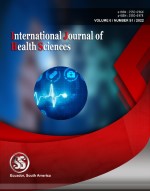Study on prevalence of CVA using non-invasive non-contrast ct scan in our population
Abstract
Background: The burden of stroke is increasing in India; stroke is now the fourth leading cause of death and the fifth leading cause of disability. Previous research suggests that the incidence of stroke in India ranges between 105 and 152/100,000 people per year. However, there is a paucity of available data and a lack of uniform methods across published studies. Objectives of this study: The objectives of this study is to estimate the prevalence of stroke in our population. Materials and Methods: All the patients were subjected to a detailed clinical history, including risk factors, previous stroke, transient ischemic attack, physical examination including vital parameter assessment, serial neurological examination, other systems examination, computed tomography (CT) of brain. Concurrently, the patients were also worked up for complete hemogram, coagulation profile, and basic biochemical parameters. Statistical Analysis: Statistical analysis was done using Microsoft Excel spreadsheet, and statistical package for the social sciences (SPSS) version 20.0 software. Results were derived using frequency and percentage, mean and standard deviation. Results: It is evident from our study that the Ischemic stroke accounted for 76% of the total and haemorrhagic stroke accounted for 24% of the total stroke.
Downloads
References
Feigin VL, Forouzanfar MH, Krishnamurthi R, et al. Global and regional burden of stroke during 1990–2010: findings from the Global Burden of Disease Study 2010. Lancet 2014; 383: 245–255.
Global Burden of Disease 2017. Causes of death collabor- ators. Global, regional, and national age-sex-specific mor- tality for 282 causes of death in 195 countries and territories, 1980-2017: a systematic analysis for the Global Burden of Disease Study 2017. Lancet 2018; 392: 1736–1788.
Horton R and Das P. Indian health: the path from crisis to progress. Lancet 2011; 15: 181–183.
Sulaja S. Old age mortality in India? An exploration from life expectancy at age 60. Int J Asian Social Sci 2016; 6: 698–704.
Dalal P, Bhattacharjee M, Vairale J and Bhat P. UN millennium development goals: can we halt the stroke epidemic in India? Ann Ind Acad Neurol 2007; 10: 130.
Naik KR. Challenges in delivering stroke care in India. Ind J Health Sci Biomed Res (KLEU) 2016; 9: 245–246.
GBD 2016 Stroke Collaborators. Global, regional, and national burden of stroke, 1990–2016: a systematic ana- lysis for the Global Burden of Disease Study 2016. Lancet Neurol 2019; 48: 439–458.
Kamalakannan S, Gudlavalleti AS, Gudlavalleti VS, Goenka S and Kuper H. Incidence & prevalence of stroke in India: a systematic review. Ind J Med Res 2017; 146: 175–185.
Murray CJ, Ezzati M, Flaxman AD, et al. GBD 2010: a multi-investigator collaboration for global comparative descriptive epidemiology. Lancet 2012; 380: 2055–2058.
Kaur P, Verma SJ, Singh G, et al. Stroke profile and outcome between urban and rural regions of Northwest India: data from Ludhiana population-based stroke regis- try. Eur Stroke J 2017; 2: 377–384.
Pandian JD, Singh G, Bansal R, et al. Establishment of population-based stroke registry in Ludhiana city, Northwest India: feasibility and methodology. Neuroepidemiology 2015; 44: 69–77.
Pandian JD, Singh G, Kaur P, et al. Incidence, short- term outcome, and spatial distribution of stroke patients in Ludhiana, India. Neurology 2016; 86: 425–433.
Ray BK, Hazra A, Ghosal M, et al. Early and delayed fatality of stroke in Kolkata, India: results from a 7-year longitudinal population-based study. J Stroke Cerebrovasc Dis 2013; 22: 281–289.
Sridharan SE, Unnikrishnan JP, Sukumaran S, et al. Incidence, types, risk factors, and outcome of stroke in a developing country: the Trivandrum Stroke Registry. Stroke 2009; 40: 1212–1218
Sultan M, Debebe F, Azazh A, Hassen GW (2017) Epidemiology of stroke patients in Tikur Anbessa Specialized Hospital: Emphasizing clinical characteristics of Hemorrhagic Stroke Patients. Ethiop J Heal Dev. 31(1): 13-17.
Published
How to Cite
Issue
Section
Copyright (c) 2022 International journal of health sciences

This work is licensed under a Creative Commons Attribution-NonCommercial-NoDerivatives 4.0 International License.
Articles published in the International Journal of Health Sciences (IJHS) are available under Creative Commons Attribution Non-Commercial No Derivatives Licence (CC BY-NC-ND 4.0). Authors retain copyright in their work and grant IJHS right of first publication under CC BY-NC-ND 4.0. Users have the right to read, download, copy, distribute, print, search, or link to the full texts of articles in this journal, and to use them for any other lawful purpose.
Articles published in IJHS can be copied, communicated and shared in their published form for non-commercial purposes provided full attribution is given to the author and the journal. Authors are able to enter into separate, additional contractual arrangements for the non-exclusive distribution of the journal's published version of the work (e.g., post it to an institutional repository or publish it in a book), with an acknowledgment of its initial publication in this journal.
This copyright notice applies to articles published in IJHS volumes 4 onwards. Please read about the copyright notices for previous volumes under Journal History.
















